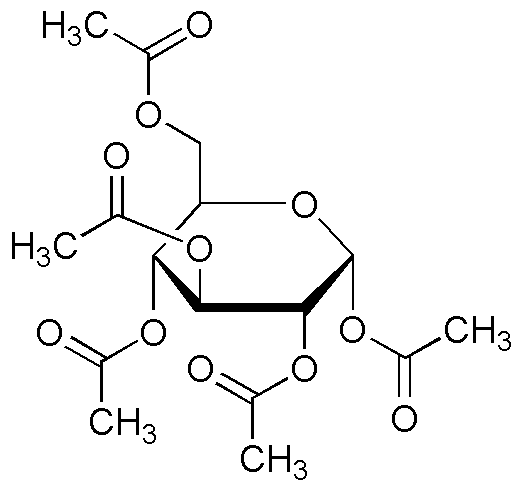a-D-Glucose pentaacetate is widely utilized in research focused on:
- Biochemical Research: This compound serves as a key reagent in studying carbohydrate metabolism and enzyme activity, allowing researchers to explore metabolic pathways in various organisms.
- Drug Development: It is used in the synthesis of glycosylated compounds, which are important for developing new pharmaceuticals, particularly in targeting specific biological pathways.
- Analytical Chemistry: The compound is employed in chromatographic techniques for the separation and analysis of sugars, providing precise identification and quantification in complex mixtures.
- Food Industry: As a derivative of glucose, it can be utilized in food chemistry to study sugar interactions and stability, which is crucial for product formulation and quality control.
- Cosmetic Formulations: Its properties make it suitable for use in cosmetic products, where it can enhance the stability and delivery of active ingredients, improving product efficacy.
General Information
Properties
Safety and Regulations
Applications
a-D-Glucose pentaacetate is widely utilized in research focused on:
- Biochemical Research: This compound serves as a key reagent in studying carbohydrate metabolism and enzyme activity, allowing researchers to explore metabolic pathways in various organisms.
- Drug Development: It is used in the synthesis of glycosylated compounds, which are important for developing new pharmaceuticals, particularly in targeting specific biological pathways.
- Analytical Chemistry: The compound is employed in chromatographic techniques for the separation and analysis of sugars, providing precise identification and quantification in complex mixtures.
- Food Industry: As a derivative of glucose, it can be utilized in food chemistry to study sugar interactions and stability, which is crucial for product formulation and quality control.
- Cosmetic Formulations: Its properties make it suitable for use in cosmetic products, where it can enhance the stability and delivery of active ingredients, improving product efficacy.
Documents
Safety Data Sheets (SDS)
The SDS provides comprehensive safety information on handling, storage, and disposal of the product.
Product Specification (PS)
The PS provides a comprehensive breakdown of the product’s properties, including chemical composition, physical state, purity, and storage requirements. It also details acceptable quality ranges and the product's intended applications.
Certificates of Analysis (COA)
Search for Certificates of Analysis (COA) by entering the products Lot Number. Lot and Batch Numbers can be found on a product’s label following the words ‘Lot’ or ‘Batch’.
Numéro de catalogue
Numéro de lot/série
Certificates Of Origin (COO)
This COO confirms the country where the product was manufactured, and also details the materials and components used in it and whether it is derived from natural, synthetic, or other specific sources. This certificate may be required for customs, trade, and regulatory compliance.
Numéro de catalogue
Numéro de lot/série
Safety Data Sheets (SDS)
The SDS provides comprehensive safety information on handling, storage, and disposal of the product.
DownloadProduct Specification (PS)
The PS provides a comprehensive breakdown of the product’s properties, including chemical composition, physical state, purity, and storage requirements. It also details acceptable quality ranges and the product's intended applications.
DownloadCertificates of Analysis (COA)
Search for Certificates of Analysis (COA) by entering the products Lot Number. Lot and Batch Numbers can be found on a product’s label following the words ‘Lot’ or ‘Batch’.
Numéro de catalogue
Numéro de lot/série
Certificates Of Origin (COO)
This COO confirms the country where the product was manufactured, and also details the materials and components used in it and whether it is derived from natural, synthetic, or other specific sources. This certificate may be required for customs, trade, and regulatory compliance.


